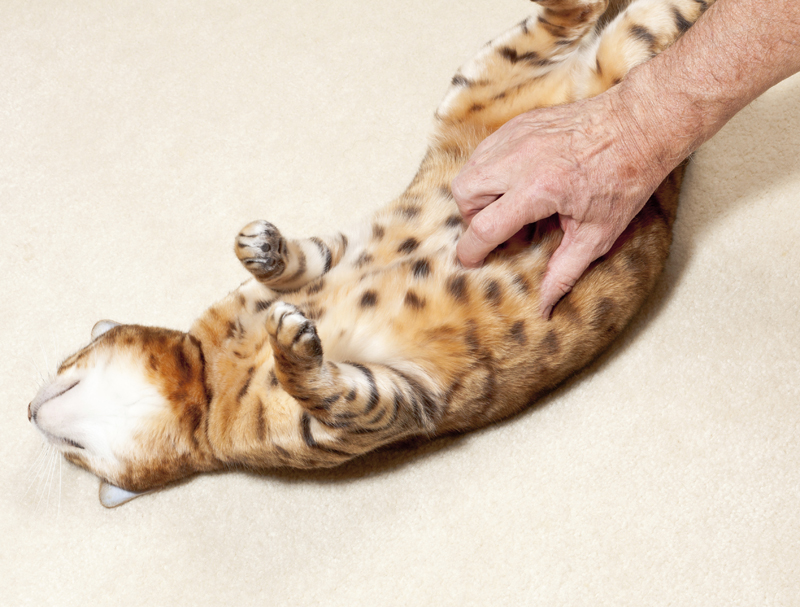Simple but profound, Tellington TTouch can help heal and calm your kitty.
The simplest things are often the most powerful. Who would think, for example, that using your fingertips to make circles on your cat’s body could have such a profound effect on his well being? With Tellington TTouch, it can.
Tellington TTouch, more commonly known as TTouch, is a technnique created by Linda Tellington-Jones in the 1970s. It involves making circular movements with your fingers or hands on an animal’s body. The intent is to activate cell function and awaken cellular intelligence – it’s a little like “turning on the electric lights of the body”, according to Linda. Just the simple act of using your fingertips on an animal’s body can speed up the healing of injuries or illnesses, or change undesirable habits or behaviors.
Linda used these techniques to develop the The Tellington Equine Awareness Method (TTEAM), a combination of exercises, signals, riding principals and circular touches.
Over the years, she modified and adapted the principals to benefit cats and dogs. TTouch is especially helpful for calming kitties that are nervous, shy or stressed.
How it’s done
TTouch is done by placing your thumb and pinkie finger as anchors on the animal’s body. Using gentle pressure, move your three middle fingers in a circle, starting at the six on the imaginary clock face, pushing the skin around in a clockwise circle back to six and then to nine – it’s a circle and a quarter motion. Release and move to a new area, either adjoining the first area or a different part of the body.
“Working with cats is in some ways the same and in some ways different from working with other animals,” says Debbie Potts, a TTEAM and companion animal practitioner and instructor who has worked with Linda for 26 years. “They have a sensitive nervous system. It is easy for them to be over-stimulated.” For this reason, according to Linda, cats may not respond to a single long TTouch session, but frequent short sessions work just as well.
What it’s used for
“TTouch is useful for so many things,” Debbie says. She is quick to explain that it is not a healing modality, but rather helps the body remember how to heal itself. “It facilitates the process faster and easier, and empowers the human to know how to help the cat.” There are three ways in which TTouch can benefits cats:
1.TTouch can be used for any health-related issue. It is soothing, reduces pain and helps the body remember how to heal itself. TTouch is good for age-related issues, plus it supports the immune system and reduces stress. Cats can get stressed pretty easily and chronic stress can challenge the immune system. TTouch also helps with the end of life process by helping it go more smoothly. It can work with problems that cannot be diagnosed by simply “letting the body do its thing.”
Debbie stresses that TTouch is not a substitute for veterinary care. Rather, it can be integrated into the medical process. A good working relationship with your veterinarian is essential.
The intent is to activate cell function and awaken cellular intelligence – it’s a little like “turning on the electric lights of the body.”
2.TTouch can be useful in emergency situations. If a cat is going into shock, the “ear slide” can help bring him out of it. Linda considers the ear slide essential in administering TTouch; it’s a good way to start a session. The cat’s ear is grasped between your thumb and forefinger, your thumb on the back of the ear. Then gently slide your fingers along the ear to the tip. Debbie has taught this technique to vet techs. It helps make treatments and medication administration easier and less traumatic.
3.TTouch is effective for behavioral issues. By looking at the cat’s body, Debbie says, you can determine areas of tension that contribute to the problem. A fearful or reactive cat shows tension in the hindquarters. By using TTouch on less sensitive areas of the body, you can build trust then move on to those more sensitive spots. Check to see if the cat is comfortable with TTouch, since he may react differently to it than to petting or massage. Like Chapin (see sidebar), some cats become active participants in TTouch.
“I have worked with cats with many different health and behavioral issues,” says Debbie. “Of course there are no guarantees, but almost all of them benefit from the experience in one way or another. Often the results are very successful.”
TTouch is not to be confused with Therapeutic Touch, a form of body work in which the hands are held over the body and the patient’s energy field is manipulated.
Anyone can do TTouch by sitting quietly, breathing deeply, and following the circular motions. For those who want to learn more, there’s a worldwide network of practitioners, workshops and training opportunities – visit www.ttouch.com and www.integratedanimal.com for more information.
Rather than simply stroking your cat when she curls up on the sofa next to you, take a few moments to offer up some tender loving TTouch.
Helping Chapin chill
Debbie’s old cat Chapin had a loving nature, but got caught up in a case of redirected aggression that led to vicious attacks on her elderly calico, Sabrina. “I did the typical human thing, running around and yelling at him,” she says.
Then she tried TTouch. She noted that Chapin didn’t like his mouth and two places on his back touched, so she worked around those points for six or seven minutes.
A couple of days later, Chapin came to Debbie and got in position to receive additional TTouch. She was able to do TTouch on the areas he previously resisted. Best of all, he stopped attacking Sabrina. Debbie says Chapin was a reactive cat and adds that TTouch brought his body into better balance so he wasn’t so reactive.







No Comment